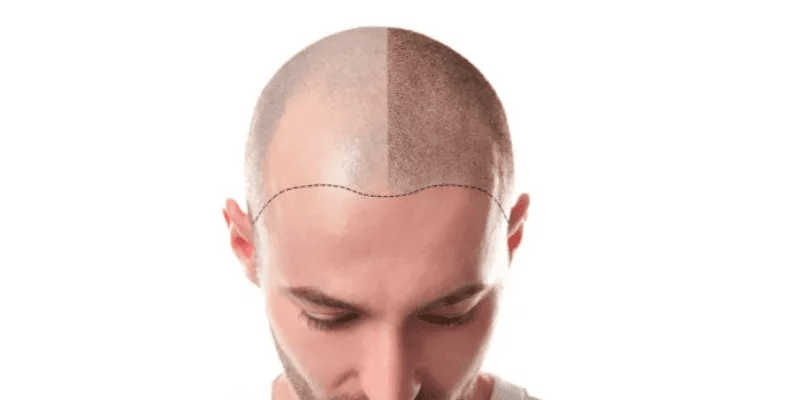How Long After Hair Transplant Rogaine?
“How long after hair transplant rogaine?” is one of the most asked questions about hair transplant aftercare. Rogaine (Minoxidil) is often used to stop hair loss or stop it from getting worse. Please keep in mind that Rogaine usually only works to bring back a receding hairline caused by male baldness. It does not help with other types of hair loss. Some people think that Rogaine is better at restoring hair in small groups than in large areas of the scalp. This means that using Rogaine early is likely to give you the best results.
Rogaine is a simple solution that works by widening the blood vessels and making more blood flow to the part of the body where it has been put on. More oxygen and nutrients that keep your hair and follicles healthy are brought into your blood when more blood flows through your skin. In the long run, this stops the hairline from receding because it stops the follicle from getting any more damaged.
How Long After Hair Transplant Rogaine Work?
Rogaine is a prescription drug that was first made as a pill to treat high blood pressure. Soon, physicists found that putting a minoxidil solution directly on the scalp could speed up hair growth. Minoxidil, a topical solution for hair loss, could help men grow hair faster than it would help women. Most women are told to use 2 percent minoxidil solution twice a day or 5 percent minoxidil foam once a day. The most common form of minoxidil is Rogaine. Rogaine contains finasteride, which has been shown to help hair grow. It may also help people with male pattern baldness grow back “lost” hair.
Some people argue online about whether or not minoxidil works on hair along the hairline. In the studies used to get FDA approval, minoxidil was mostly tested on the top of the scalp and the crown. This led to the common misconception that it only works in these areas. Even so, there is a lot of evidence that minoxidil, along with the hairline, works well to make hair grow all over the scalp.
In this guide, we’ll look at the studies on minoxidil to help you understand how it works, why it’s safe, and why you should try it (along with finasteride) if your hairline is getting thinner and receding.
How Does Rogaine Help?
So, we can say that Rogaine opens up the blood vessels and makes the blood flow faster. In theory, this lets more oxygen and nutrients from the blood get to the hair follicles. It is more likely that hair would grow faster and be healthier on follicles that are stronger and thicker. Getting more blood to the hair follicles is a common way to improve them and make hair grow faster. Several other active medicines and treatments work in the same way. Minoxidil wasn’t meant to be used to treat hair loss at first. It was rather a way to treat high blood pressure. Researchers started to look into whether it could be used as a treatment for hair loss after they saw hair growing in places where it shouldn’t have.
Minoxidil is usually put on as a liquid or foam. This process should be done several times a day. It is also a pill that can be taken by mouth. This is only okay for the drug’s generic version, though.
Even though there may not be a magic pill that makes your hair grow back, rogaine is one of the treatments that has been shown to help keep more hair from falling out. This main drug was used to stop hair loss from getting worse. It was made for other reasons, but people began to use it to treat hair loss.
How Long After FUE Hair Transplant Using Rogaine Enough?
Minoxidil can help stop hair loss in certain situations. About 40 percent of men who use it will start to grow hair in three to six months. It has only been shown to work for people under the age of 40, though. Like some other drugs, minoxidil works better if you have just started to lose your hair. Rogaine is allowed to be used to stop balding. But it doesn’t stop baldness. Instead, it helps keep hair healthy and helps it grow.
The hormone dihydrotestosterone, which is the main cause of pattern baldness, does not stop it. How does Rogaine work? What is it? It’s important to know that if you stop using minoxidil, your hair may start to fall out faster than before. Rogaine, on the other hand, hasn’t been proven to work for receding hairlines. In the experiments that showed how well the medicine worked, the top of the head was used as a test area. Some people have said that the hairline is strong.
Will Rogaine Help If Your Hairline Is Getting Thinner?
A lot of people all over the world deal with some types of hair loss. So it shouldn’t be a surprise that a lot of people are looking for drugs that can slow or even stop the decline. Minoxidil is a drug that is used in many brand-name treatments for hair loss. If your hairline is getting thinner, you might be wondering if this treatment would help. Minoxidil works by increasing the flow of blood to the area where it is put.
If you put it on your scalp, the number of hairs on your head will grow much faster and more densely. Because of this, there is no reason why minoxidil shouldn’t work on a receding hairline. The hair follicles in your hairline are not very different from those in your scalp or crown. This means that putting minoxidil on your hairline will also help you grow hair. People with receding hairlines have also been using minoxidil to make their hair grow faster and thicker in recent years. Today, though, there is no systematic clinical research on how minoxidil affects the hairline. Minoxidil isn’t a surefire way to fix your hairline. Instead, it’s better to think of it as something that might help.
It’s also important to remember that Rogaine works best when used with a DHT inhibitor like finasteride. Studies show that minoxidil and finasteride may have a stimulating effect on reducing hair loss. This is why the two medicines are often used together to protect the hairline and scalp from alopecia.
How Long Does a Hair Transplant Take to Heal if You are Old?
A hair transplant procedure can be a great way to restore hair growth in areas that have been affected by genetic baldness or other types of hair loss. However, if you are an older individual, it is important to know the answer to ‘how long does a hair transplant take to heal?’ The healing process of hair transplant may take longer for an older individual than it would for someone younger. Generally speaking, an older person may require more time for the scalp to heal and for the newly transplanted hair to start growing in.

Typically, the healing process may take three months or more. During the first week after your hair transplant, you will likely experience some redness, swelling, and tenderness. At around three weeks post-transplant, the transplanted hair will begin to shed known as “shock loss” and it occurs because the new follicles are adjusting to their new environment. If you are an older individual considering a hair transplant procedure, remember that it may take several months for the healing process to be complete and for you to start seeing results. It can take up to six months or longer for newly transplanted hair to start growing in, which hopefully answers ‘how long does a hair transplant take to heal if you are old?’



